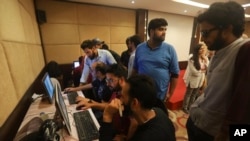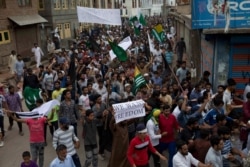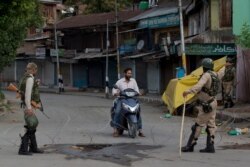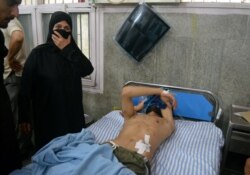In the two weeks since India stripped Kashmir of its semi-autonomous status and brought the Himalayan region under its direct control, news reporting has become difficult and local newspapers have either not published or struggled to deliver slim editions. That is not just due to the communications blackout caused by disconnected landlines, mobile phones and the internet, but because it has been tough to access troubled areas or sources in a region being patrolled by thousands of security forces.
In Srinagar, the summer capital of Kashmir that turned into a maze of barricades to keep a lid on protests, New Delhi-based freelance journalist Sonia Sarkar had to constantly navigate checkpoints during her three-day trip to the city last week. And while the administration is handing out access passes to journalists, she said security officers often discouraged her from reaching downtown areas known to be hotspots. “There is an attempt to create a perception of fear, a fear psychosis to prevent you going ahead.”
While Sarkar managed to get around much of the city, she was turned back before she could reach Soura, a densely populated neighborhood that some believe is turning into the focal point of resistance to New Delhi’s decision to change Kashmir’s status. The BBC and Al-Jazeera reported a mass protest in Soura on August 9. The government first denied the demonstration happened, then said about 1,000 to 1,500 people took part.
'Information vacuum'
Authorities have said that journalists are free to visit and report from the region; but, local media in the Kashmir valley have had a hard time printing newspapers, gathering news, accessing sources or filing reports.
Since the clampdown on August 5 – the day India made the dramatic announcement of the change in Kashmir’s status – the daily Kashmir Times had not printed its Srinagar edition until now (Wednesday). Editors have struggled to connect with their staff. "Until about two days ago there was not a single communication from our staffers in Srinagar and from different districts in the valley. There was a complete information vacuum," according to Anuradha Bhasin, executive editor of the Kashmir Times, who is based in Jammu, the Hindu majority region that lies outside the Kashmir valley.
Hostility to local journalists
Ironically, to print the Jammu edition, they had to rely on reports coming from Delhi such as TV channels and news agencies for nearly two weeks. “Security forces were more hostile to the local journalists; some media persons were intimidated or heckled,” according to Bhasin.
And despite some respite in the strict security clampdown, many areas in the Kashmir valley remain off limits. “It's only in Srinagar there is some movement. But they are unable to go into the most affected areas.”
With restrictions eased somewhat in recent days, reporters were able to file a few stories from Srinagar, but on Tuesday, Bhasin waited in vain for some stories to show up. She does not know the reason.
Some local reporters have said that they prefer passing off as local Kashmiris visiting patients in hospitals to get past checkposts. And gathering information and viewpoints has been a challenge because restrictions on movements have kept most people indoors and most political leaders and activists are in detention.
Over the last decade, internet access and mobile devices have been cut off several times in Kashmir, a region often wracked by violence since a separatist movement erupted 30 years ago. Landlines were never disconnected, however, making it possible to gather news.
Authorities said Tuesday that most landlines have been restored, but those in the area that is a hub of Kashmir’s media offices still do not appear to be working.
Local media under surveillance
The government has established a media center at a hotel in Srinagar to enable reporters to file their stories, but with only four computers, there has been a huge rush. “All they can manage to do is to file one or two stories hurriedly; they have to wait for their turn and all your work is under surveillance,” said Bhasin.
In a statement on August 10, the Editors Guild of India denounced the lockdown as “almost total and draconian for the vibrant local media that are the first eyes and ears on the ground.”
For reporters coming from outside Kashmir too, getting an accurate picture is not easy. There has been news about frequent protests but reports of such demonstrations have largely been based on eyewitness accounts.
“Trying to reach someone, or trying to go and meet someone or make a contact was impossible right from Delhi onwards” said Anubha Bhonsle, also a New Delhi-based independent journalist, who spent five days in the valley last week. She said she managed to go wherever she wanted but added, “You have to maneuver your way through the blockades. It was not easy in the first go.”
Bhonsle said in one instance, she believed the olive green clothes she wore helped her get past a checkpost as she was probably perceived as a female officer. She said she was able to enter a hospital from where reporters usually gather information on people wounded in protests because “I was nimble and without excessive camera gear.”
Taking videos on regular broadcast cameras was tricky, barring a few areas from where most TV channels work. “The big broadcast cameras only came out in places where there was relative calm,” said Bhonsle.
Most New Delhi-based TV channels have said that there is little resistance in Kashmir to the government’s moves and projected a picture of relative normalcy, which journalists like Bhonsle and Sarkar said does not reflect reality.
“The camera was the enemy, because of reports people were seeing on television screens of unbridled normalcy, which made people angry because the situation was not normal,” said Bhonsle.
Journalist Sarkar said she had to take videos “very discreetly” because security forces would stop her and in one case asked her to delete a video even though it was nothing controversial. And very few Kashmiris, who exchanged views with her, were willing to speak on camera or even give their full names. “This has never happened; in Kashmir everybody has always been very willing to talk. Now they are extremely careful.”
Sarkar recalls reporting trips to Kashmir during turbulent times in 2010 and 2016. “Reporters from Delhi were never stopped from doing their job. Even on curfew days we could move around.” But this time, “There is this sense that I got that there was an attempt to control the movement, control the narrative that comes out of Kashmir,” she noted.










